Monsoons and My Grandfather’s Storehouse of His Gods
Monsoons in the Philippines make me smile. They bring back fond memories of my childhood spent in the company of two aunts who never got married, a widowed uncle, his two daughters, and another cousin. (I thought they were my sisters because they were already there when I was born.) We all lived in one house—my Grandfather’s Bahay na pawid, where my three cousins, a brother (an older and only one), a sister, and I were born. It was a house made of bamboo and palm leaves—a large version of a Bahay Kubo. My parents lived there, too, despite having their own. It was just the way it had to be.
My grandfather—we called him Amang—had seven kids, my mom the bunso in a brood of six sisters and one brother. I never knew my grandmother, who died when my mom was still a baby. Widowed early, Amang supported his children by working on his small farm. He would grow rice during the wet season, corn, and some of the greens you heard in Bahay Kubo when it was dry.
Amang also grew tobacco and made his cigarillos. My brother and I would always volunteer to chop the leaves and roll them in thin paper to make cigarillos for Amang, my uncle, and their friends. It was always an opportunity for my brother and me to hide an extra roll we could light and puff. We would do this in secret until we got dizzy and disoriented, earning us a pingot (ear-pulling) from our mom.
On many monsoon nights, Amang, together with my uncle, would go out to the rice fields early in the evening and come home before the break of dawn, soaking wet and muddy. From catching frogs, dalag (mudfish we call bulig in Bulacan), Talankang Bukid (rice paddy crabs), and susong kuhol—that mollusk you find in the ricefields. My brother and I would get up early to check out what they had in their buslo (bamboo baskets used by farmers for their catch). If there were small dalags, Nana Kikay (Kikang to us kids)–mom’s elder sister–would let us keep them in a big garapon (jar) filled with water. That garapon was our best version of an aquarium. We would feed the fish with house spiders and mumo (rice particles left on the plate) until the scales fell off their skin and then die before the week was over. With the water getting murky each passing day, I shouldn’t wonder. We never changed the water, don’t ask me why.
In Amang’s house, monsoons meant Palakang Tinola (stewed frogs); Palakang Botsog (frogs stuffed with roughly-chopped alagao tops and finely cubed ginger, then deep-fried in oil); Pinalundag na Dalag. English translation? Search me! (I could only describe it as a bunch of medium-sized live mudfish in a clay pot lined with fresh tamarind fruits, smothered with salt, and a cup of white vinegar. Cover the pot and shake it vigorously before putting it on the hot stove.) There was Lagat na Hito (catfish in vinegar, turmeric, and alagao tops (a herbal plant)) and Halabos na Talangkang Bukid (steamed rice paddy crabs), and stewed Susong Kuhol (mollusks in broth with fresh ginger leaves and pepper)—goodies from his farm Amang described as the storehouse of his gods. For Tinolang Palaka, there would always be the right ingredients in Amang’s backyard garden: green papayas, green ginger, and chilis—their leaves, not the malungay leaves, the essential component that makes an authentic Bulacan tinola. There was no place for Malungay leaves in Amang’s kitchen. It was not popular among the locals back then. Their use was mainly for inducing milk for breastfeeding mothers until people from faraway regions like Ilocos and Bicol entered my town and established residence. With them, their cuisine.
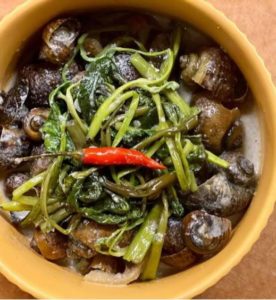
I never had Susong kuhol (rice paddies mollusk) until I was in my 20s. Photo credit: Elvie Osorio-Dalida
The Bulakenyo kitchen has never been the same again. Growing up, we did not eat katurays (hummingbird tree blooms) and saluyots (jute) or gabi (yam) leaves. Coconut milk was for rice specialties. I never had susong kuhol in coconut cream until I was in my 20s. You see, we only knew what my grandfather could get from the storehouse of his gods.
When there were no dalags for us to keep until the water turned murky, there would always be Palakang Bukid (ricefield frogs). They would be our toys until they get beheaded, skinned, stewed, fried, or stuffed with herbs. But unfortunately, Kikang, our aunt and cook, could not do the beheading. So the job fell to her little ax-men, who were me and my brother, our tiny hands covered in ashes from our clay stove for us to have a firm hold of the poor amphibians struggling to get free.
And then there were the Talangkang Bukid—the rice paddy crabs. Grandfather knew where to find them. They dug holes into rice paddies where they could hide or hibernate. He knew snakes could also hide in those holes and yet never hesitated to poke them barehanded or chanced upon a snake in any of them. If he ever did, he survived the bite and lived long.
Talangkang Bukid, when steamed or broiled, exudes a sweet-bitter smell in the air, making you either hungry or puke. I puked all the time. As a child, I never liked the smell. Until now, I find the scent of burning crab shells or crustaceans cooking in boiling water repulsive. It reminds me of eggs in a pot of boiling water left unattended until the pot’s surface was pitch black; the eggs were a burnt offering.
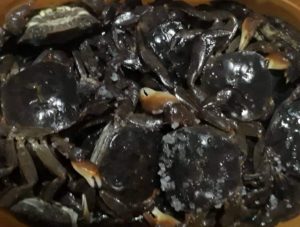
Burong Talangkang Pehe (Fermented pehe crabs). Photo credit: Renan Pinto
Monsoons at my grandfather’s house meant Burong Talangka (fermented crabs). Not the Talangkang bukid (rice paddy crabs) but the Talankang Pehe (river crabs). The gods of my grandfather didn’t have them in their storehouse. The fishmongers in our palengke have banyeras (fish tin-bucket) running over with Pehe crabs; you would find some of them frantically crawling on the floor. When you hear a crackling sound under your feet, you know you have just stepped on one—the shell crashed flat, and the sole of your shoe is Safran yellow.
My aunt would buy them by the tabo. They didn’t sell them by the kilos then, not in our palengke. So the tabo of my childhood was a used plastic motor oil container, the size of a liter. As before, the tabo is an essential feature in every Filipino bathroom, but that’s another story.
Once at home, my aunt would begin fermenting the live crabs in a clay pot and dump heaps of rock salt over them until they were ready to eat in three days. I thought the method was brutal because I could see the poor little creatures crawling in a frenzy, struggling to escape. Once the pot was closed with a lid, the bitter end—rather salty—for the pehes. I would listen to the eerie little noise they made inside the crowded pot until I could only hear the sound of silence. Hello, Darkness, my old friend. Yes, the poor crabs trapped inside their death chamber fermenting must have inspired Simon and Garfunkel to compose their famous, now iconic, song.
I would have the most extended face at the dining table at home when our ulam (dish; viand) was fermented crabs. First of all, I was not fond of them. As a child, it was difficult for me to press the meat cum alige out and smother them into a plate of piping hot rice. The hot rice was another thing. Everyone, even my brother but for me, could scoop the steaming hot rice into their mouth with a bare hand. I would either spit them out or keep them in my mouth while blowing air to cool them down. I was not a fan of spicy sawsawan (dipping sauce), either. Then when dinner is over, you hear the loudest burp in the neighborhood.
When there was no burong talangka, there would always be talangkang halabos (steamed crabs).
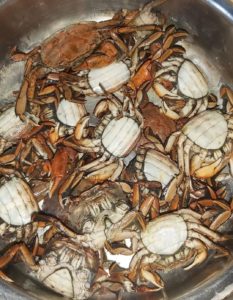
Halabos Talangkang Pehe (Steamed pehe crabs). Photo credit: Renan Pinto
I don’t know why everyone in my family craves them. They were messy and not easy to eat. I tried to eat them the way my aunt and the others at the table would—split the talangka in half, bite on the shell, and suck out whatever meat or juice there was to them. When dinner was over, I would realize that I consumed more rice than crab meat, despite the heaps of waste on my plate—sucked out-to-dryness crab body parts.
Monsoons make me reflective. My grandfather and his Bahay na Pawid have been gone for many years. Ditto with several dear family members: my parents, my two aunts, my uncle, a cousin, and my brother. Gone were his rice fields—the storehouse of his gods.
The road to Manila from my hometown during my childhood was long and bumpy. It never bothered me because I enjoyed the view of the long stretch of rice lands you see along the way–a breathtaking landscape of green during the rice-growing season and gold during harvest. Unfortunately, my childhood’s beautiful landscape of green and gold is gone. The rice lands have become real estate subdivisions and freeways, depriving the dalags, the rice paddy crabs, frogs, and mollusks, of their natural habitat. They are now hard to find. Dalags you can get from the market any time, but they come from fishponds. They don’t taste the same; my cook knows better.
Cook is my cousin, 82 years old, but still going strong. Well, not that strong, but agile enough to go to the market. When she does, she comes home with everything from chicken feet to a kilo-and-some of small fish to alimasags (blue crabs) – the smallest she can find, the better.
„Sa mga pusa ko ba yan?” (Are the fish for my cats?) I would ask. “You know I don’t eat them! “
“E ako, kumakain nyan,” (But I do) would be her proud reply, giggling. OMG! I give her the money so she can buy what she likes. Hello?
“Kahit mga pusa ko di yan kakainin.” (Even my cats won’t eat them). She would ignore me.
Her justification: “The chicken feet for my Arroz Caldo and sotanghon (glass noodles).” She knows I don’t eat chicken feet. She does.
And why the smallest of alimasags? She would say the small alimasags are sweeter, and she could not find baklang alimasags. Baklang what? I thought she was mocking me. I didn’t know they existed.
I asked how she would know the alimasag was bakla (gay). Perhaps the way it walks on the beach, sashaying with little pink umbrellas, with a rainbow-colored wrap-around, and crawling with limp tentacles? Or spend hours on the beach to get a shinier, bluer than blue shell? Those?
“Mas maraming alige at malaman” (they have more crab-roe and meaty). She sounded apologetic, worried she might have offended me with her description of the crab.
“Kaya mas mahal sa lalake at babaeng alimasag! “(Therefore, more expensive than the male and female crabs), she explained further with a naughty wink.
“Dapat lang!” (They better be!) was my quick, tart reply; my left eyebrow arched so high it could touch the ceiling of my house, both roaring with laughter.
Mud crabs I eat, if only for the alige. Otherwise, I don’t crave them.
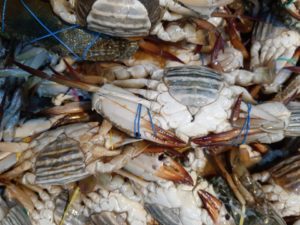
My fishmonger in my hometown told me that you could tell the gender of the crabs by the shape on the underside of their shell; The females have round shapes; the males are pointed. Photo credit: Vinia Ramos
In Vienna, where I live, I made ginisang sotanghon (Sauteed glass noodles). I came across a cooking website with a recipe on sotanghon with mud crabs bursting with alige. The pictures whet my appetite, so I went to my favorite Chinese grocer in the city to get live mud crabs imported from the Netherlands.
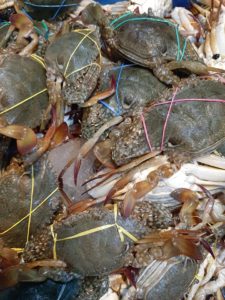
Female, Male, Bakla? Crabs, in any case. Photo credit: Vinia Ramos
Cut the crabs in halves, the recipe said. I have a butcher knife in my kitchen, but cutting the crabs in half was brutal. Whenever I put the sharp knife on the crab to find where the blade should land, the crab’s eyeballs would pop out of the eye socket. It was like it could sense that something sinister was about to happen. I felt terrible doing this to the poor crab, but I had to. I hit the shell so hard that the alige splattered all over the kitchen tops, the tentacles still moving. I thought it was still alive. I pulled the next one out of the basket and placed it on the chopping board. It struggled to get off the chopping board despite a thick rubber band tied around its shell and tentacles. I miscalculated where the blow would land, splitting the crab into two uneven portions, one much bigger.
Never again, I said to myself, especially after a dinner guest at the table dropped a loathsome comment after hearing my story.
“Maybe you’ll be a crab in your next life.” I was stunned. She said this while catching her breath between sucking a crab claw and stuffing herself with heaps of my sotanghon. I had the sudden urge to pull the dinner plate away from her. Must be something in the crabs or sotanghon? Either she had one too many before dinner, plain blöd, or both. Bitch!
Now you made me crave for burong talangka!!! Not the frogs though
You are one courageous girl! :)